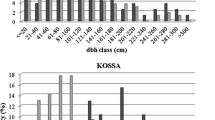Abstract
Natural flora, vegetation, diversity and structure of 62 traditional coffee–banana plantations on Kilimanjaro were investigated and compared with the other vegetation formations on this volcano on basis of over 1400 plots following the method of Braun-Blanquet. The vegetation of the so-called Chagga homegardens belongs floristically to the formation of ruderal vegetation forming two main communities that are determined by altitude. These coffee–banana plantations maintain a high biodiversity with about 520 vascular plant species including over 400 non-cultivated plants. Most species (194) occurring in the Chagga homegardens are forest species, followed by 128 ruderal species, including 41 neophytes. Typical of the agroforestry system of the Chagga homegardens is their multilayered vegetation structure similar to a tropical montane forest with trees, shrubs, lianas, epiphytes and herbs. Beside relicts of the former forest cover, which lost most of their former habitats, there are on the other hand (apophytic) forest species, which were directly or indirectly favoured by the land use of the Chagga people. High demand of wood, the introduction of coffee varieties that are sun-tolerant and low coffee prizes on the world marked endanger this effective and sustainable system.
Similar content being viewed by others
References
H.J. Beentje (1994) Kenya Trees, Shrubs and Lianas National Museums of Kenya Nairobi
J. Braun-Blanquet (1964) Pflanzensoziologie Springer Wien
D.R. Brewin (1965) ArticleTitleKilimanjaro agriculture Tanganyika Notes Records 64 115–117
V.M. Clemm (1963) ArticleTitleAgricultural productivity and sentiment on Kilimanjaro Econ. Bot. 18 99–121
Downie C. and Wilkinson P. 1972. The Geology of Kilimanjaro. University of Sheffield.
FAO 1986. Rehabilitation of traditional schemes (Phase I), Tanzania AG: TCP/URT/4522, Mission ReportRome.
E.C.M. Fernandes A. Okting’ati J. Maghembe (1984) ArticleTitleThe Chagga homegardens: a multistoried agroforestry cropping system on Mt. Kilimanjaro (Northern Tanzania) Agroforest. Syst. 2 73–86
J. Fjeldså D. Ehrlich E. Lambin E. Prins (1997) ArticleTitleAre biodiversity ‘hotspots’ correlated with current ecoclimatic stability? A pilot study using the NOAA-AVHRR remote sensing data Biodivers. Conserv. 6 401–422 Occurrence Handle10.1023/A:1018364708207
InstitutionalAuthorNameFTEA (1952–2003) Flora of Tropical East Africa Royal Botanic Garden Kew
T.V.D. Hammen D. Mueller-Dombois M.A Little (1989) Manual of Methods for Mountain Transect Studies IUBS Paris
A. Hemp J.C. Winter (1999) ArticleTitleErgebnisse der ethnobotanischen Forschung am Kilimanjaro Bayreuther Forum Ökologie 64 117–144
A. Hemp (1999) ArticleTitleAn ethnobotanical study on Mt. Kilimanjaro Ecotropica 5 147–165
A. Hemp (2001a) ArticleTitleEcology of the pteridophytes on the southern slopes of Mt. Kilimanjaro Plant Biol. 3 493–523 Occurrence Handle10.1055/s-2001-17729
Hemp A. 2001b. Life form and strategies of forest ferns on Mt. Kilimanjaro. In: Gottsberger G. and Liede S. (eds) Life forms and Dynamics in Tropical Forests. Dissertationes Botanicae 346, pp. 95–130.
A. Hemp (2002) ArticleTitleEcology of the pteridophytes on the southern slopes of Mt. Kilimanjaro. Part I: Altitudinal distribution Plant Ecol. 159 211–239 Occurrence Handle10.1023/A:1015569125417
A. Hemp (2003) Climate impacts and responses on Mount Kilimanjaro S. Agrawala A. Moehner (Eds) Development and Climate Change in Tanzania: Focus on Mount Kilimanjaro OECD Paris
Hemp A. in press a. Continuum or zonation? Altitudinal gradients in the forest vegetation of Mt. Kilimanjaro Plant Ecol.
Hemp A. in press b. Ecology and altitudinal zonation of pteridophytes on Mt. Kilimanjaro. In Proceedings of the XVIIth AETFAT Congress 21–26 September 2003.
Hemp A. in press c. The impact of fire on diversity, structure and composition of Mt. Kilimanjaro’s vegetation. In Proceedings of the GMBA Symposium 19–24 August 2002 in MoshiTanzania.
Hemp A., Lambrechts C. and Hemp C. (in press). Global Trends in Africa: The Case of Mt. Kilimanjaro. UNEP, Nairobi.
C. Hemp A. Hemp (2003) ArticleTitleSaltatoria coenoses of high-altitude grasslands on Mt. KilimanjaroTanzania (Orthoptera: Saltatoria) Ecotropica 9 71–97
Hemp C. in press. The Chagga home gardens – relict areas for endemic Saltatoria species (Insecta: Orthoptera) on Mt. Kilimanjaro. Biol. Conserv.
C. Hemp (2001) ArticleTitleEthnozoological research on invertebrates on Mt. KilimanjaroTanzania Ecotropica 7 139–149
W.J. Kress (1986) ArticleTitleThe systematic distribution of vascular epiphytes: an update Selbyana 9 2–22
E.M. Lind M.E.S. Morrison (1974) East African Vegetation Longman London
N. Mdoe S. Wiggins (1997) ArticleTitleReturns to smallholder dairying in the Kilimanjaro region, Tanzania Agr. Econ. 17 75–87 Occurrence Handle10.1016/S0169-5150(97)00006-6
P.K.R. Nair (1993) An introduction to agroforestry Kluwer Dordrecht
InstitutionalAuthorNameNational Bureau of Statistics and Central Census Office (2003) 2002 Population and Housing census. Genaral report The United Republic of Tanzania Dar es Salaam
O’Kting’ati A. and Kessy J.F. 1991. The farming system on Mount Kilimanjaro. In: Newmark W.D. (ed), The Conservation of Mount Kilimanjaro. The IUCN Tropical Forest Programme, pp. 71–80.
A. O’Kting’ati J.A. Maghembe E.C.M. Fernandes G.H. Weaver (1984) ArticleTitlePlant species in the Kilimanjaro agroforestry system Agroforest. Syst. 2 177–186 Occurrence Handle10.1007/BF00147032
J.C. Ramsay (1965) ArticleTitleKilimanjaro – sources of water supplies Tanganyika Notes Records 64 92–94
M. Rikli (1903/1904) ArticleTitleDie Anthropochoren und der Formenkreis des Nasturtium palustre DC Berichte der Zürcherischen Botanischen Gesellschaft 8 71–82
W.A. Rodgers K.M. Homewood (1982) ArticleTitleSpecies richness and endemism in the Usambara mountain forests, Tanzania Biol. J. Linn. Soc. 18 197–242
Schmidt P.R. 1989. Early exploitation and settlement in the Usambara Mountains. In: Hamilton A.C. and Bensted-Smith R. (eds), Forest Conservation in the East Usambara Mountains Tanzania. The IUCN Tropical Forest Programme, pp.75–78.
Simmonds N.W. 1966. Bananas, 2nd edn. London.
H. Sukopp I. Kowarik (1987) ArticleTitleDer Hopfen (Humulus lupulus L.) als Apophyt der Flora Mitteleuropas Natur und Landschaft 62 373–377
H. Sukopp A. Langer (1996) ArticleTitleCampanula rapunculoides – ein Apophyt in der Vegetation Mitteleuropas Verhandlungen der Gesellschaft für Ökologie 25 261–276
L. Timberlake (1986) Krisenkontinent Afrika Hammer Wuppertal
G. Volkens (1897) Der Kilimandscharo. Darstellung der allgemeineren Ergebnisse eines fünfzehnmonatigen Aufenthalts im Dschaggalande Reimer Berlin
Widenmann A. 1899. Die Kilimandscharo-Bevölkerung. Anthropologisches und Ethnographisches aus dem Dschaggalande. Petermanns geographische Mitteilungen, Ergänzungs-Heft 129, 104
Author information
Authors and Affiliations
Corresponding author
Rights and permissions
About this article
Cite this article
Hemp, A. The Banana Forests of Kilimanjaro: Biodiversity and Conservation of the Chagga Homegardens. Biodivers Conserv 15, 1193–1217 (2006). https://doi.org/10.1007/s10531-004-8230-8
Received:
Accepted:
Issue Date:
DOI: https://doi.org/10.1007/s10531-004-8230-8




